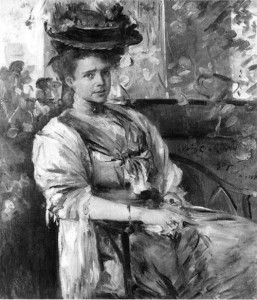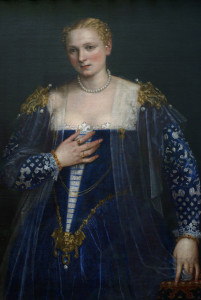When I saw the ‘Portrait of Greta Moll’ in the National Gallery I was taken aback. I felt that her character somehow overshadows her artistic presentation: a penetrating look with a touch of humor, a light—yet reserved—smile, curious inquisitive eyes wide open, the feminine roundness of the body leaning almost incidentally against the orange table, impatient, generously allowing Matisse to paint her yet eager to go. She seemed to me so independent and free spirited; in a minute she would stand tall, take her farewell and leave the artist longing to complete the portrayal of her unique character.
Greta Moll (1884-1977) and her husband Oskar were part of a very small group – ten people at most – of Matisse’s original students. Greta was a German sculptress, painter and author. Her appealing appearance, her free spirit and intellectual and artistic talents captivated the attention of many. Matisse decided to paint her after seeing a black-and-white photograph of a her portrait made by the German artist Lovis Corinth. Looking at the photo he declared, with open contempt, that Corinth had failed to represent her ‘youthfulness’. Taking up the challenge, he suggested he would himself make a portrait of Greta.
This was Matisse’s first commissioned portrait. It was painted in the spring and early summer of 1908, in his studio in Paris. Rather pragmatically, he insisted that Greta and her husband should be charged 1,000 francs, but they wouldn’t have to buy the picture if it failed to please them. Portraiture, Matisse knew, is a tricky form of art. It consists of two conflicting elements: a desire to please the subject of the painting, to present him or her in an appealing manner; but also to portray a mood, a state of mind, qualities that might not appear at all attractive. Greta would certainly like to look beautiful. He, however, would venture to unearth her unique quality, perhaps in a way that would fail to appear ‘beautiful’.
The Portrait of Greta Moll may appear simple, almost as if it was made with a couple of swift brushstrokes. But Greta posed for ten days, three hours every day, until it was ready. Matisse didn’t allow her see the unfinished work. But after ten days Greta and Oskar came to the studio, where Matisse unveiled it. They were full of admiration: Greta’s blue eyes and blond hair (which Matisse used to say reminded him of ripe corn or honey) were pretty, she looked lovely, charming and feminine. The couple, eager to take the portrait, expressed their full satisfaction. Both the artist and the model agreed that the portrait was strikingly like Greta, and the couple went home pleased.
But not Matisse.
He felt he had failed to capture Greta’s unique character, “In spite of my best efforts…. I had gone no further than the charming features which were not lacking in my model, but I had not managed to catch her statuesque aspect.” This was all wrong. The more charming she appeared, the more falsified the portrait was. Greta had something overwhelming about her, she wasn’t only ‘a beauty’. And portrait painting is the art of unearthing profound aspects of an individual, an inner world, rare perspectives.
Matisse wasn’t sure how to fix the portrait. But he recalled a painting he had seen in the Louvre, La Bella Nani, by the sixteenth century artist Paulo Veronese. After Greta and Oskar left he rushed to the Louvre to see it. “The proportions of the model were almost the same as Mm. Moll’s”, he later wrote. Standing facing La Bella Nani he found what had been missing: grandeur, an expressive gesture of the hands, an intense gaze. The freedom of the Renaissance artist to portray drama and intensity of emotions made him aware the limitations of his own work. Naturally he wasn’t going to adopt the Renaissance style; he only wished to extract a certain quality from the painting, and grant it a modern expression.
Matisse went back to the study and began working on the portrait. After an hour it was dramatically changed: the woman’s colors and features were intensified, details suppressed, the arms became massive, Matisse had given her a modern grandeur, the “statuesque quality” he was looking for: “abandoning all caution, I worked on it for an hour, perhaps two, ending up with a feeling that I had been most satisfactorily delivered.”
When Greta and her husband saw the finished portrait they were devastated. She was appalled by the huge arms and the bushy eyebrows. They missed the blond curls and the delicate colors. But they decided to keep it. And gradually Greta connected with herself as she was portrayed by Matisse, and came to love the painting. She was later quoted as saying “I could kill a man who owns it in order to call it mine.”
I find the portrait overwhelming. And Greta seems to me imposing, whatever her hair, eyebrows and arms looked like.



Thanks!
wow ! very interesting and beautiful
Thanks, Nils. Very interesting, I was unaware of this struggle over the painting.
I find it extremely expressive.
All best, Emanuela
Very interesting article, Emanuela! Maybe it was only a comissioned work by courtesy.
And there is another strory behind this painting: http://www.telegraph.co.uk/news/2016/09/08/grandchildren-of-matisses-muse-sue-national-gallery-for-reclaim/
Best regards, Nils
Thanks, Yasmine!
Excellent portrayal of a portrait Emanuela,I just loved it as well as the portrait itself…! Thank you as ever,best day wishes,Yasminew